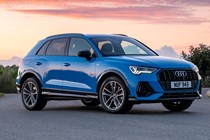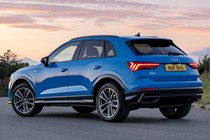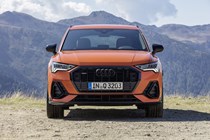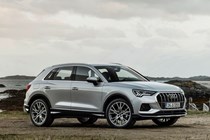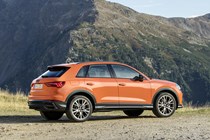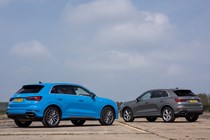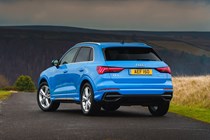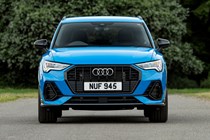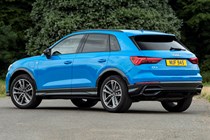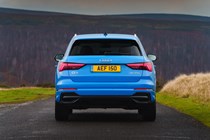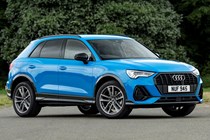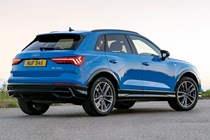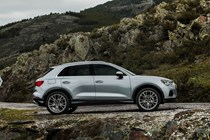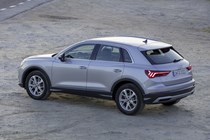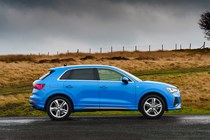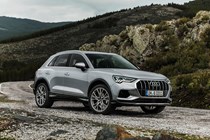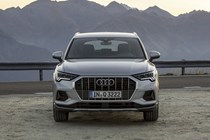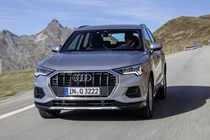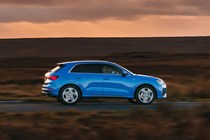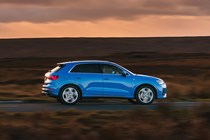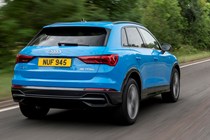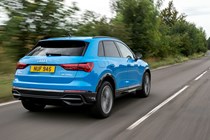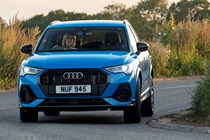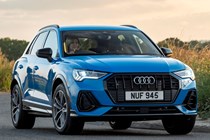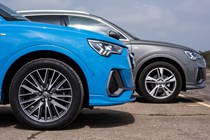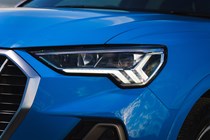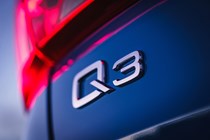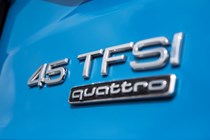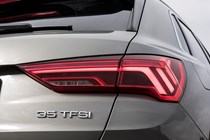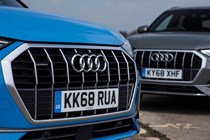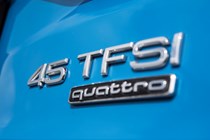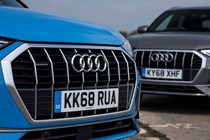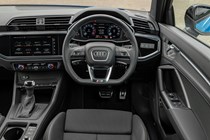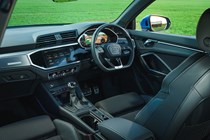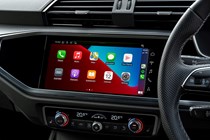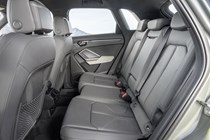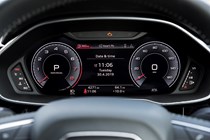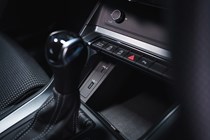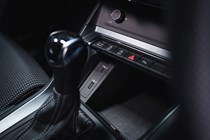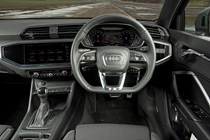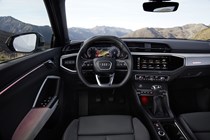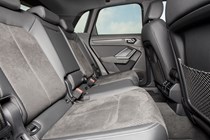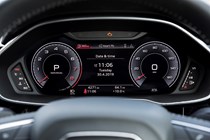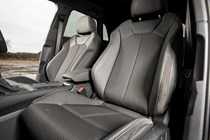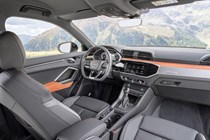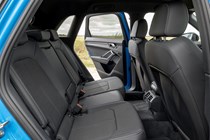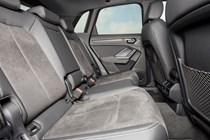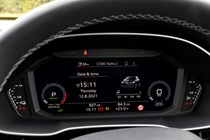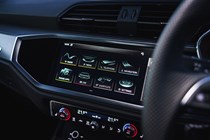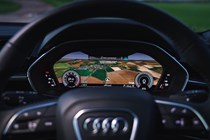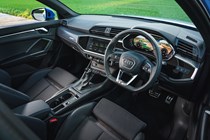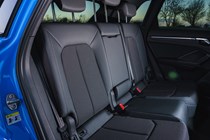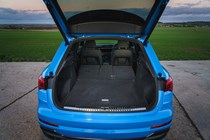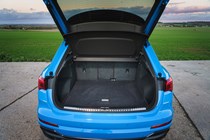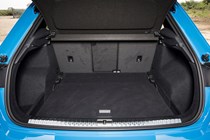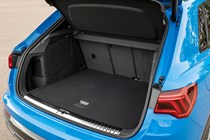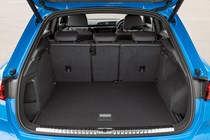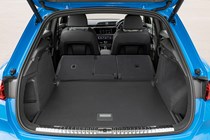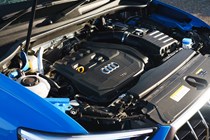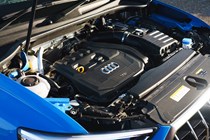Audi Q3 long-term test
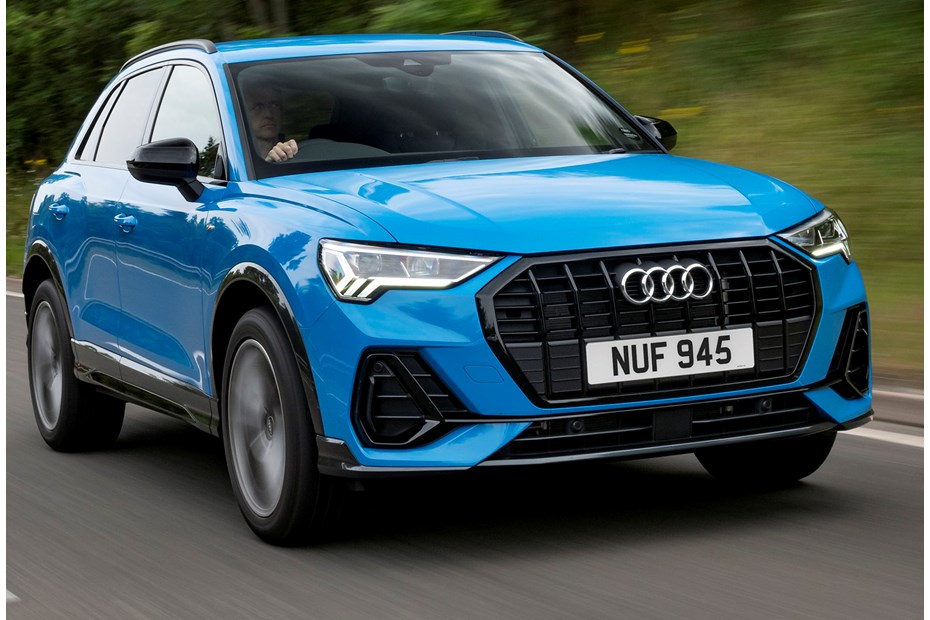
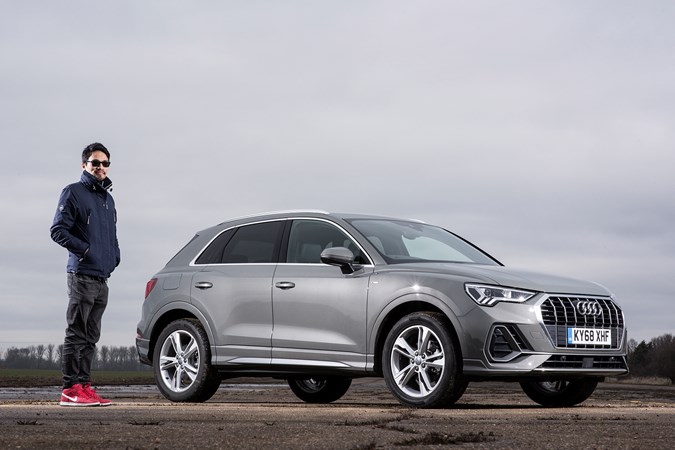
Ah, the Audi Q3. One of those cars that previously failed to register on my radar. That’s not to say it was particularly terrible or offensive, but I just struggled to find anything appealing about it. I thought the ballooned-A1 styling was lazy, while the interior and driving experience were as bland as couscous.
The previous one also felt like it had been on sale for…well, forever, so its replacement in 2018 seemed well overdue.
Now in its second generation, this one feels like it’s found the mojo it never had. The old model’s sad-looking face has been replaced with something far more striking and, while the rest of the car looks similar in profile and design, it’s far less dumpy overall.

The front grille is large and dominates the face, but in a good way, and the angular vents and LED light signatures add a touch of aggression. I’m not sure the design would still feel fresh after another eight years though, should this generation remain on sale for the same length of time.
Which Audi Q3 do we have?
We’ve got ourselves the best-selling model: the 35 TFSI S line. The lower-emission two-wheel drive version should mean lower running costs over the four-wheel drive Quattro model and the petrol engine means it’s more refined than its diesel counterpart – if you keep it below 4,000rpm that is.
The 35 TFSI engine produces 150hp, but never feels sprightly. If anything it feels a little underpowered and perhaps a little strangled. You can’t help but feel a little short-changed with this lacklustre performance when the price tag is more than £33,000; even more so when ours is optioned up to be over £37,500. The PCP finance costs are similarly high. The good news is that Q3s continue to be offered with low monthly prices on Personal leasing (PCH) contracts.
It might be less thirsty than the 2.0-litre 45 TFSI petrol (that’s the 230hp version to us) on paper, but we’ll soon see if the larger engine is worth paying extra for. Otherwise, the 1.5-litre TFSI engine and myself have something in common: we’re not too happy about having to physically work hard. And that pretty much sums up the whole car really.
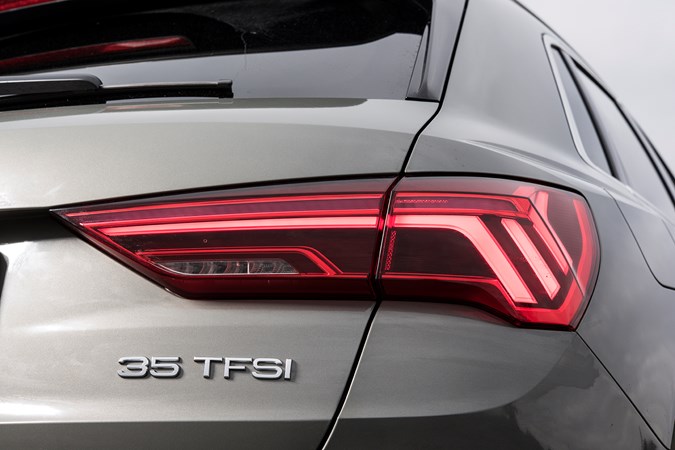
Drive the Q3 in a relaxed manner and you’re right in this car’s sweet spot; it’s comfortable, quiet, refined and relaxing. Just like Tom Goodlad’s A5 long-termer, I don’t care about driving fast in it at all – I’ll just waft everywhere. Ask any more from it though, and it begins to falls apart (not literally, but dynamically).
We’re running the smooth-shifting S tronic automatic gearbox and it’s largely impressive. The biggest reservation we have so far is that it needs heavy throttle inputs before it responds. It’s fine on the move when it will downchange for you when you need to pick up the pace, but it’s way behind our BMW M140i and its telepathic response. The hesitation when setting off at standstill at junctions is what kills it though, even if Audi is not the only manufacturer to suffer from it (Jaguar Land Rover I’m looking at you).
First impressions
We’ll delve into the options we’ve chosen in the next update but, for now, I’m looking forward to spending some time in something that could while away the miles. It’s not the most exciting car to drive, especially as it serves as the successor to the rapid and much-missed Peugeot 308 GTi, but that might be a good thing when all you want is a nice place to wind down after a hectic day.
Hopefully it’s not so effective to be sleep-inducing, but for now, it’s far more memorable than a Volkswagen Tiguan – a car I only know I’ve driven due to pictorial evidence.
Update 2: what options have we got?
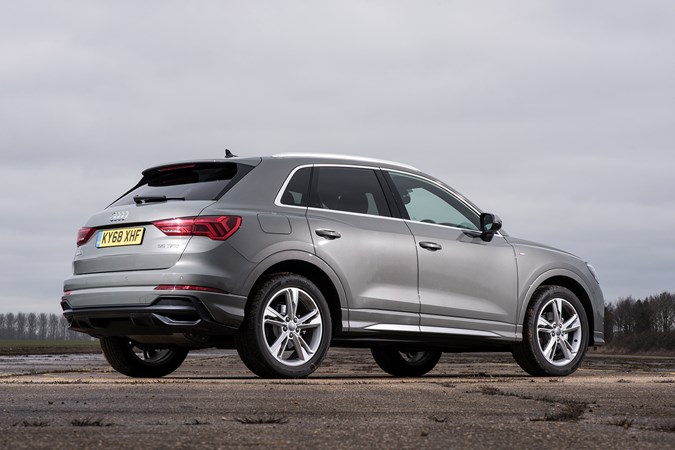
Our Q3 is certainly one of the smarter looking cars on the Parkers long-term fleet, but even in S line trim, it’s not the most striking to look at. In the not-too-distant past, opting for an Audi S line model would come with a big bodykit, chunky alloy wheels and a detox of chrome detailing – all swapped out for gloss black highlights. In short, it would visually look like a high-end model, sitting just below the full-fat S and RS sports models.
Now though, our Q3 S line sits in the middle of the range and almost looks like a halfway house. We certainly like the bigger 19-inch wheels, rear privacy glass and sportier bumpers, but to get the de-chromed look, you’ll have to get the flagship Vorsprung model. At the time of writing, the cheapest one of those is a whole ten grand more than the cheapest S line model. Ouch.
I mean, how many cans of spray paint can you get for that?
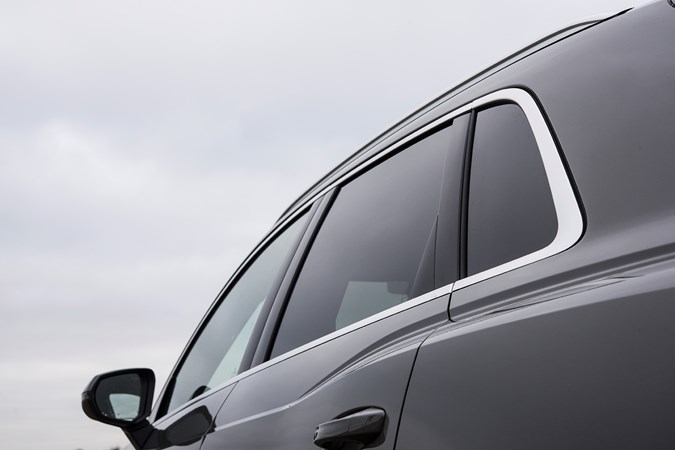
Once you get over that though, I still quite like how our long termer looks. I think the best way to view it is from the side at a height, as it brings out all the crease lines that lend it a more muscular look. Otherwise, without them in view, our small SUV can look a little slab-sided – especially in our darker Chronos grey colour.
Speaking of which, this shade of grey hasn’t been much of a hit with people. It’s certainly not an offensive colour, but the slightly yellow-ey basecoat almost makes this look like a Nardo Grey that’s gone stale.
Still, the brighter Turbo blue is available, as is Pulse orange for the same price. Or if you have to have grey, the deeper, pearlescent Daytona shade can be had.
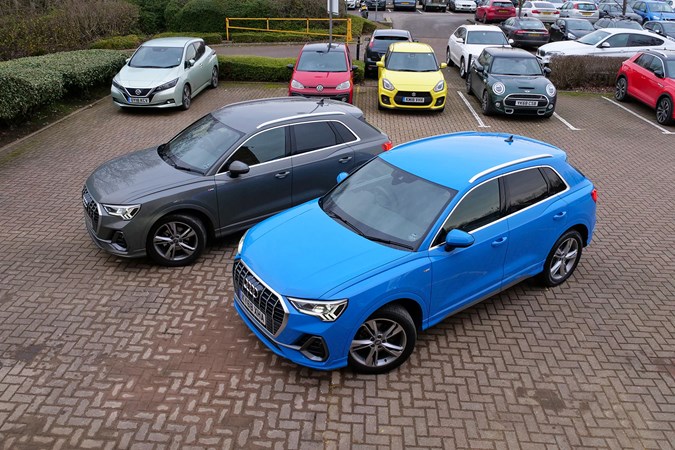
Elsewhere, the fitted options on our Q3 comprise of:
- Storage Pack
- Multi coloured ambient lighting
- Virtual cockpit Plus
- Flat-bottom steering wheel
- Electric front seats
- Heated front seats
- Electric folding door mirrors
- Four-way lumbar support
- Parking system plus
- Audi Sound System
The multi-coloured ambient lighting option allows you to choose between 30 different colours, with added lighting strips on the front and rear doors and an illuminated Audi logo (or Quattro, if you chose that option), on the dash in front of the passenger. The light-up doors I definitely approve of, but that logo? Feels like overcompensation to me.
The Storage Pack includes nets on the back of the front seats, a storage compartment under the front passenger seat, owner’s manual holder under the driver’s seat, luggage net in the boot and two LED lights in the tailgate. The latter makes a big difference at night as they shine down when the tailgate is open.
Virtual cockpit Plus brings a larger 12.3-inch digital instrument screen, upgrading from the 10.25 version and helps the Q3 look more premium.
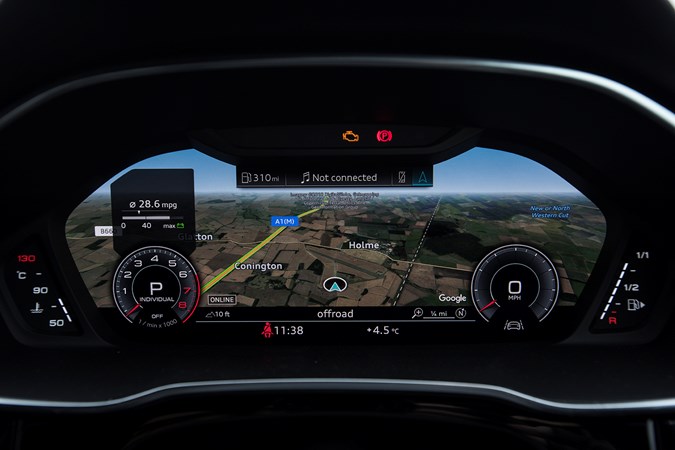
The Audi Sound System upgrade is also worthy, with a 180 watt output being fed through 10 speakers and a sub-woofer, rather than the standard six. It may not be the Bang & Olufsen system found on Vorsprung models, but feels like a worthy stepping stone to the full Volume 11 option.
Most of these options have been useful, adding to the Q3s comfort and convenience, although some of us would expect a few of these to come as standard, especially the seat functions.
The flat-bottomed steering wheel option is also not worth £250, especially when it looks so out of place in an SUV. The Q5 didn’t have one either and I never missed it in this kind of car, so if you are having to pick and choose between your options, this is easily one to forgo.
Any other options available?
The other options available on our S line model extend to a rear-view camera, adaptive suspension, rear side airbags, space saver spare wheel, a panoramic glass roof, high-beam assist, wireless phone charging and driver assistance technology including adaptive cruise control, park assist and traffic sign recognition.
Again, we’d expect a rear-view camera to be standard at this price point, but other than the spare wheel, these are the only two additions we’d make. We’ve yet to try a Q3 with adaptive suspension, but we’ll find out when we compare this with the 45 TFSI. More soon.
Update 3: Should I consider a VW Tiguan instead?
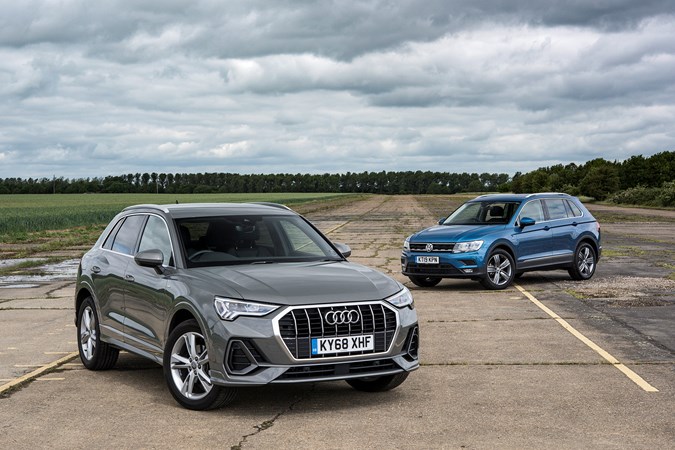
Since the Q3 uses the same platform as the similarly-sized and cheaper Volkswagen Tiguan, SEAT Ateca and Skoda Karoq, is it worth the extra outlay to opt for our long termer?
That’s quite an important question to ask if you’re keeping an eye on your budget, so we’ve brought the Tiguan here to compare. The trouble is, whenever anyone mentions this medium-sized SUV from VW, I always find myself asking a more fundamental question instead: Have I even driven a Tiguan before?
That pretty much says how memorable this car is to me, which may sound a little harsh, but if I have to scroll through my phone for pictorial evidence of one to remind me of it, that’s quite telling.
This time, though, having spent a prolonged amount of time with a 1.5-litre Match, I’m more of a fan. So much so, I think it makes more sense than my Q3.
This particular Tiguan isn’t a direct comparison with my Q3 S line in terms of equipment, but this VW still comes with plenty of kit despite being approximately £6,000 cheaper. Sure enough, it doesn’t have drive modes, electric seats, virtual cockpit, or a powered tailgate, but the only thing I genuinely wished for was the last item when I had to manually open and close the boot lid. And that’s just because I’m lazy.

Besides, it won’t cost £6,000 to option the Tiguan back up if you wanted a few choice options.
You can read a more in-depth comparison with these two in our twin test (linked below), but in short, I got on with the Tiguan far better than I expected.
They both drive like an SUV but the suspension on the Q3 feels unnecessarily firm with no real benefit and my long-termer’s gearbox is also more ponderous. The engine is a little bit sweeter in the Tiguan in that it’s willing to rev a bit higher if you ask more from it, and it’s a little more refined with the absence of steering wheel vibrations under acceleration.
The engine is less rough on a cold start, too.
We averaged a reasonable 38.9mpg during my time of testing in the Tiguan, and while that’s possible in the Q3, it felt more attainable in this VW on a regular basis. Perhaps because the engine doesn’t feel like it’s being worked so hard in this one.
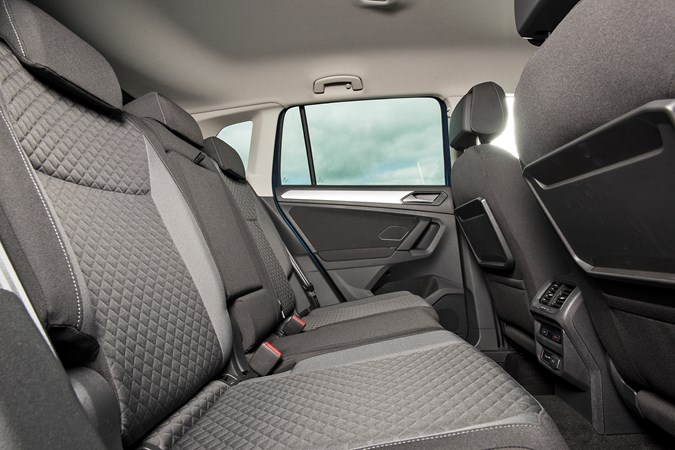
Ergonomically, the cabin is better in the Tiguan with the larger rotary knobs for the climate control and shortcut keys for the touchscreen. Plus, the absence of black headlining means it’s a brighter place to spend time in, while those in the rear are treated to folding tables.
The biggest gripe with the Tiguan was the stubborn sat-nav, which was completely unwilling to reroute when I had to follow a diversion off the A1. We were halfway down the diverted route before the system finally stopped telling me to do a U-turn.
So, Tiguan or Q3? If you’re choosing the 1.5-litre engine, get the Tiguan. The posher Q3 makes much more sense with a bigger engine, distancing itself away from the Tiguan to feel like a genuine upgrade. Since you need to spend the extra cash for a Q3, you may as well get a better engine to suit anyway.

Read the full twin test between these two SUVs
Update 4: long-distance comfort
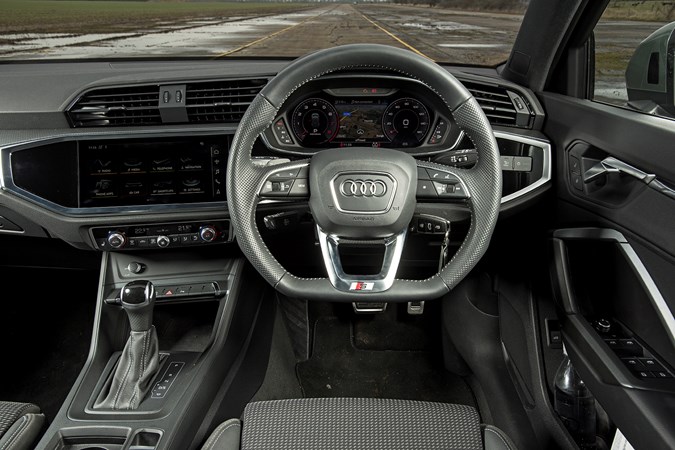
It’s time to focus on my long termer’s comfort. Yes, I still miss how the Peugeot 308 GTi made the majority of my journeys fun, but if the Audi can be so comfortable to while away any long distance trips before I get bored, I’m all for it. Our previous long-term Q5 and A5 cabriolet were fantastic at this, but does having a lower number in its name automatically mean it’s a downgrade?
Not necessarily. The cabin might look more upmarket than most rivals, but it doesn’t take long to see where costs have been cut in the choice of materials used. That said, all the important features required to make long journeys tolerable for me are mainly here.
Granted, there are a few optional extras that help: heated front seats, four-way lumbar support and electric adjustment are all individual options added to our car, but the firm bolstering on the seats already go a long way for providing long-distance support. The adjustable seat base is also a bonus for those with longer legs.
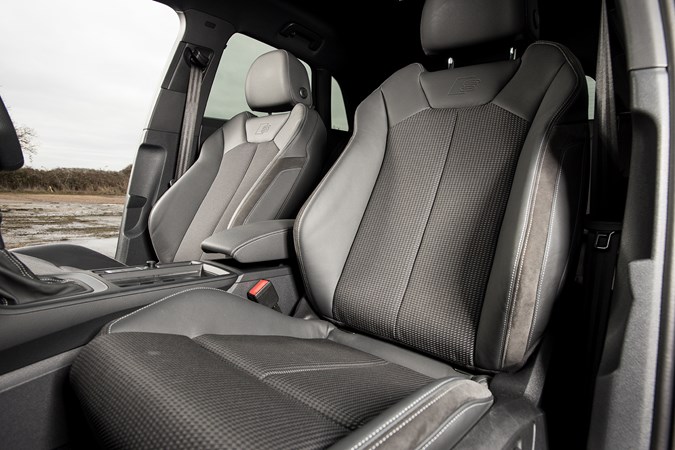
The optional multicoloured ambient lighting may not be the most practical way of spending your money, but it does make a big difference. Jump into a rival, or even any car without it and you almost feel blind as you can’t see where parts of the cabin are outlined. It’s makes a huge difference in reducing tiredness, especially when driving on un-lit roads, and makes more of a difference on our darker S line model with its black headlining.
Besides, I’m a sucker for this kind of stuff anyway, even if the light-up Audi badge on the dash is vile enough to make me wince – but thankfully it’s out of sight most of the time
The Audi Sound System upgrade is also worth having, with its 180 watt output being fed through 10 speakers and a sub-woofer, rather than the standard six. It may not be the Bang & Olufsen system found on Vorsprung models, but feels like a worthy stepping stone to the full Volume 11 option.
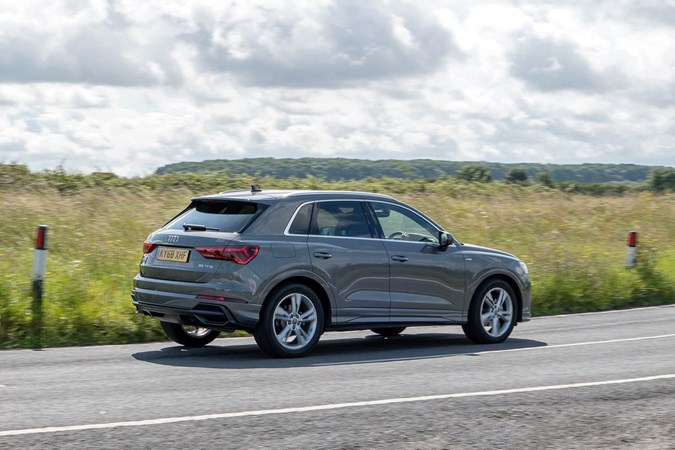
Move away from the options list and you have a very refined and comfortable SUV. The ride quality is firmer on this S line model, but still isolates bumps from entering the cabin. Road noise is also well suppressed, while wind noise around the windows is only notably present at motorway speeds. The engine needs working hard to get up to speed and sounds like it’s in pain when doing so, but it will settle down blissfully into the background.
There are also little details which can make a weekend of driving slightly less stressful and the Q3’s range on a full tank of fuel is one of them. We normally see at least 475 miles indicated on the trip computer and we have seen this creep up to 500 miles on occasion, meaning we can just get on our way without searching for a fuel stop – the diesel model should be even better.
The standard-fit LED headlights are bright and have a fantastic range, while the sat-nav was also good at navigating into London, if a little less so out – this inconsistent choice of routing is the same with most manufacturer systems, but we were genuinely surprised with this one. It was certainly more successful at tackling the same route than my previous Peugeot 308 GTi or a Kia Niro PHEV, that’s for sure.
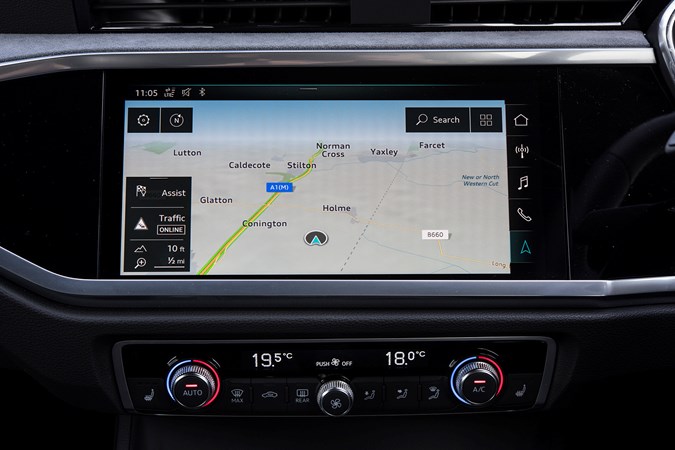
Any gripes?
The indicators are far too quiet, especially when other members of the team have had their vocal toddler in the back seat alerting them the presence of every other car on the road. In terms of keeping the cabin as quiet as possible, you could facetiously view this level of detail as something to be applauded, but in reality it’s just annoying.
So there it is, perhaps a slightly personal list tailored to my requirements when it comes to comfort, but it’s still one that the Q3 ticks off with ease. I was fearing the three and a half hour slog up to Newcastle to see some friends but the Q3 shrugged it off without hesitation.
Update 5: that automatic gearbox…
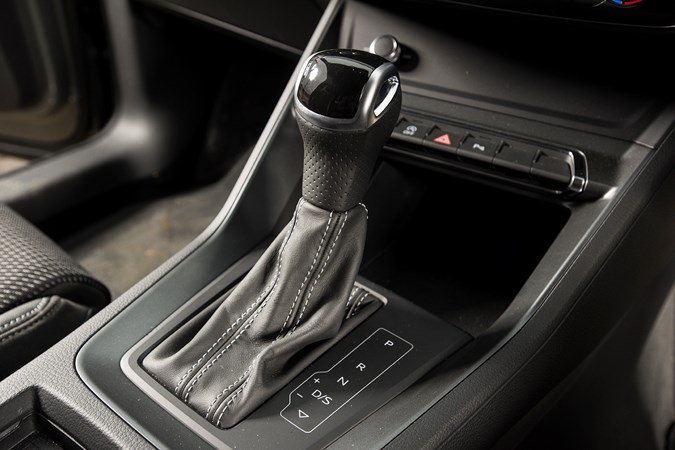
It’s time to bring our attention to the most talked about aspect of our long-term Q3: the automatic gearbox. You can guarantee it will be mentioned whenever anyone drives it and it’s chiefly down to its slow and lethargic responses.
We certainly appreciate the smooth gearchanges, but whether you want to set off promptly from a standstill or want it to change down a gear when you’re on the move, you often feel like you’re being left floundering.
The 1.5-litre petrol engine and DSG automatic gearbox we have here is one of our least favourite drivetrain combinations to come from the Volkswagen/Audi group and is widely used in other cars with varying degrees of frustration.
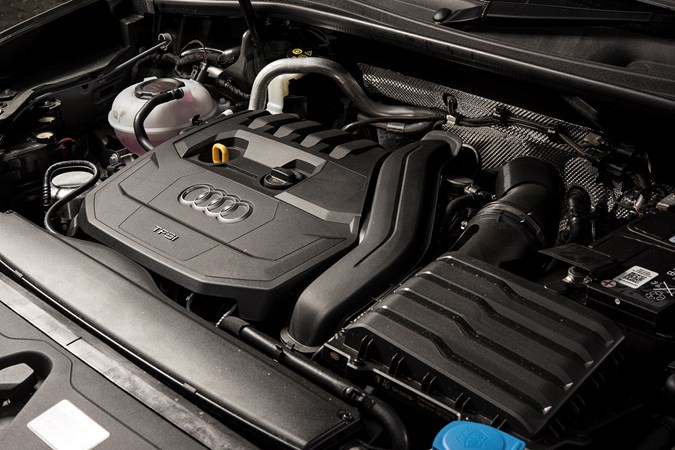
The time it takes our long-termer to accelerate after you’ve pressed the right pedal is about as infuriating as waiting for phone signal after it’s dropped out.
You can improve things a little by pressing Drive Select and choosing Dynamic mode to sharpen up the throttle response and nudging the gearlever from D into sportier S setting. Both of these prevent the gearbox from changing up a gear so soon – so rather than changing gear when the engine reaches just over 2,000rpm for example, it does so at a higher 3,500rpm instead; allowing you to access a little more power available when you need it.
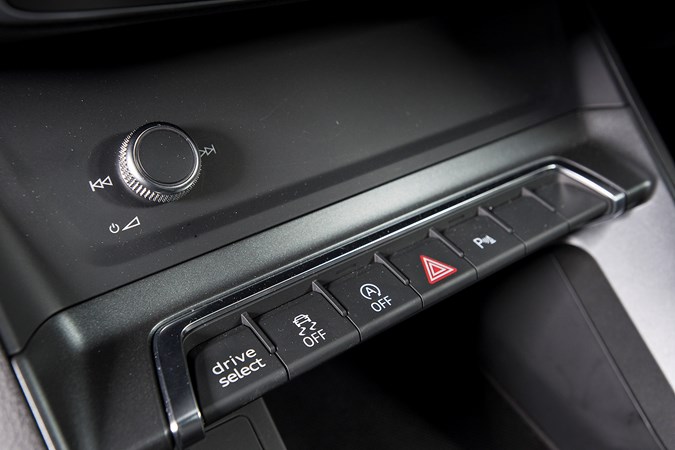
You can go one step further by pulling the left gearshift paddle on the steering wheel and keep changing down gears to reach even an higher engine speed, but the downside to all this is the lack of refinement from the coarse-sounding engine. You also lose the start-stop function in Dynamic mode when you come to a standstill.
Sure enough, there are other cars fitted with automatic gearboxes on the market that are worse offenders. The Mercedes B-Class B 180 Sport, for example, is one of the latest additions to the list – a car with so much hesitation from standstill that it caused one of our testers to drive the long way home in order to reduce the number of Give Way junctions they had to encounter.
Is it just our car? Time for a comparison test
As our Production Editor, Percy, was running a Volkswagen Arteon with the same engine and gearbox, we decided to swap cars to see how the two compared.
.jpg)
The Arteon performed better from stationary, as it was a little more eager to respond from here.
The engine continues to be a bit coarse in the Volkswagen, but the added refinement in the Arteon results in a far more hushed experience for more of the time compared with my Q3. You can still hear it droning away when worked hard, but it’s far more distant-sounding than inside my SUV.
On the move, the gearbox continues to frustrate with its reluctance to change down a gear whenever a brief burst of acceleration was needed.
.jpg)
This was especially so when we joined a roundabout and needed to get up to speed with traffic, where we’d often discover that we were left in one-too-high a gear.
As time went by, we instinctively accompanied such manoeuvres with a pull of the left gearshift paddle on the steering wheel each time, just before accelerating, but even then this wasn’t ideal – especially if you slowed down to a point where you ended up changing down to an extremely vocal first gear.
.jpg)
In the Q3, if you press the accelerator pedal all the way down, it will change down by up to two gears. In the Arteon, it only goes down by one, which feels bit stubborn in comparison, but I guess this would be ideal if you’re trying to drive like a chauffeur and keep progress as smooth as possible.
So, in short – the Q3 is better once on the move, but the Arteon is better at setting off from stationary.
Update 6: Farewell
After nine months of living with a Q3, my time with the small SUV has come to an end. At the beginning, I stated how the previous generation of this Audi never made it onto my radar for a number of reasons.
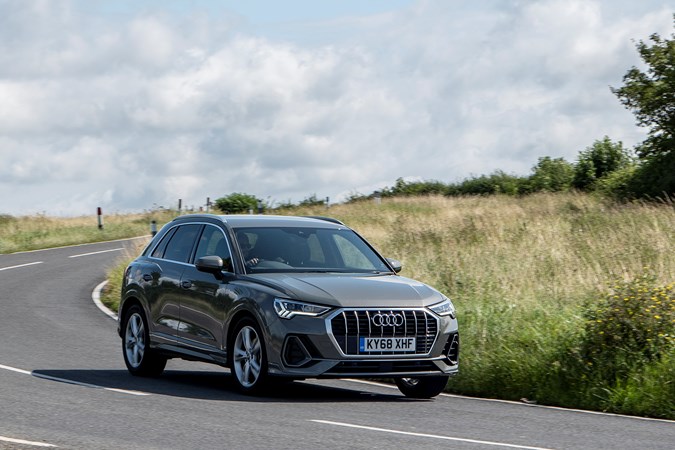
For a start, this type of car isn’t what I’m looking for in the first place, and if it was, I’d just have the sharper-looking and sharper-to-drive Range Rover Evoque. In comparison, the Q3 at the time just looked and felt so bland I could barely feign any interest.
Now though, having lived with the latest model, I’m quite sad to see this Q3 go.

It’s not been the most exciting car to drive, but I’ve discovered that’s largely been irrelevant – I know this car offers a relaxed driving experience, and it does it well. Sure enough, there are a couple of aspects that are easy to pick out as being a bit…below-par, such as the interior quality compared to other Audis, and that underwhelming engine.
But at least you can avoid the latter, although the cabin is something you’ll have to put up with. Despite the more expensive models coming with patches of Alcantara to jazz up the cabin a little, you can’t get away from the vast amounts of budget-looking plastics that dominate the cabin in here.
It’s a shame, as the rest of the Q3 is a convincing package: it’s spacious, practical and well engineered with just a few minor quirks.
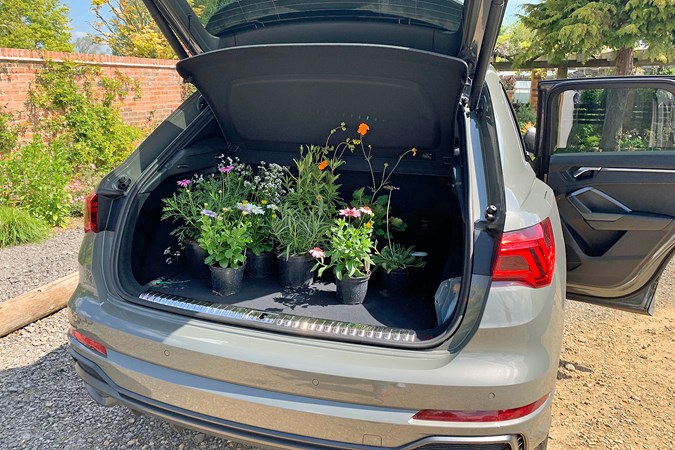
Did anything go wrong?
The check engine light made an appearance a couple of times, but shortly disappeared like nothing happened.
At just 6,000 miles in, a warning message popped up on the Virtual Cockpit screen stating ‘please check oil level’. We were quite surprised to see this requiring a top-up so soon, and a quick check revealed the level had dipped just below the minimum mark. A litre of 0W-20 later, and all was fine.
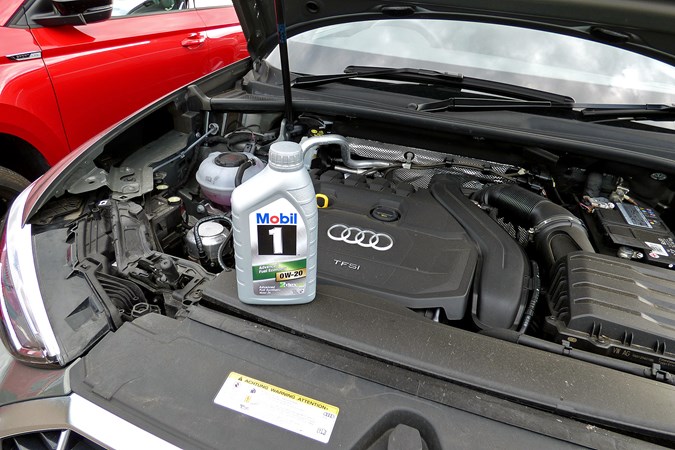
Would I recommend one?
Yes, but depending on the engine and spec you go for.
Our 1.5-litre petrol engine is rough, lethargic and linked to a dim-witted gearbox. It’s fine once you’re cruising on the motorway, but if you want this engine, you’ll be better off in a Tiguan that’s both cheaper to buy in the first place and much smoother to drive.
Here’s what we like about our Q3:
The comfort
There’s plenty of space inside wherever you sit and the supportive front seats mean this is great for long journeys. Boomy engine noise aside, the Q3 is engineered well elsewhere, with little road or wind noise filtering into the cabin. The ride is a little firm over bigger bumps on our S Line model, but the suspension absorbs them well enough to remain comfortable and avoids the Q3 from pitching or wallowing too much.
Made for motorways
The blindspot monitoring light is positioned on the door mirror casing, rather than the mirror glass itself and makes it far more useful than any of its rivals. This is a VW Group design trait I’m probably most appreciative of, as it’s easy to see when it’s lit up in your peripheral vision.
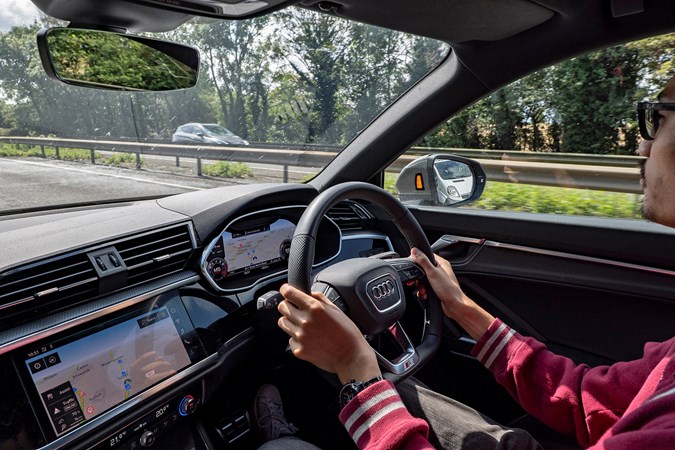
Having the light on the mirror glass also means it can be susceptible to glare, so you can’t always see it when it’s reflecting light from the sun or a headlight behind you. Fundamentally, if I have to check my mirrors for the blindspot light in the first place, I’d have to look and see what’s in my blindspot anyway.
We also like the range on a full tank of fuel, and that we’d seen indicated figures of over 40mpg on gentle motorway drives. Our best was 46.2mpg over 27.3 miles with an average speed of 37mph.
What didn’t we like?
We appreciate the amount of space available, but the black headlining that comes on S Line models makes the cabin dark and slightly claustrophobic.
The latest infotainment system takes time to get used to as well – I certainly miss the old version that came with a rotary controller – but this annoys with the amount of sub menus available. I can go to the music menu, find a radio station, but not my saved favourites without going into a sub menu. The old layout of just viewing my preset stations is much more user friendly.
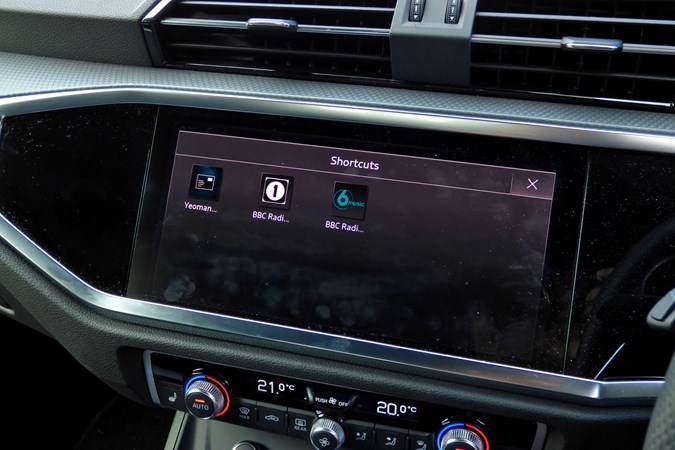
You have the option to add them as a shortcut from another screen too, but this is also redundant as the shortcuts menu is buried in a separate place altogether that needs finding. The touchscreen also isn’t as responsive as it could be.
Oh – and the indicator tick is too quiet and you can barely hear it.
Which one should I get?
The 45 TFSI is the sweet spot in the range if you decide to go petrol – even if the mpg figures are considerably lower in the mid-30s, this successfully rounds off the Q3 as the premium package it’s trying to be against its rivals.
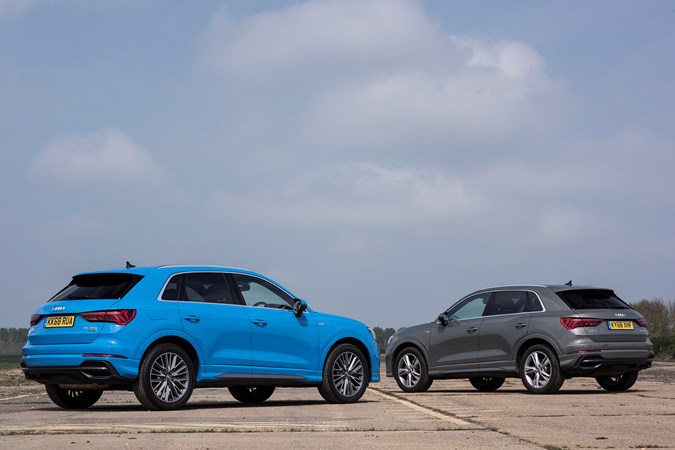
That said, it’s worth trying the 190hp 40 TFSI first, as this may offer the balance of performance and economy. Get the Volkswagen Tiguan if you want the 1.5-litre TFSI – the entry-level diesel will be a better bet if you want the cheapest entry point into a Q3.
What about the Sportback?
Joining the Q3 range later on was the sleeker-looking Sportback. The looks might be preferable to some, and it drives in the same manner as our long-termer, but we found it was far more cramped in the rear seats – to the point that it couldn’t fit three of us in and we had to bail and seek something else.
Besides, if you want a practical and sleek-looking family hatch, get the Volkswagen Arteon.
All in all, I’ve had my mind changed about the Q3 as a car. If I was looking for a comfortable family SUV, this would be on my shortlist. Would I still have an Evoque? It’s certainly more cramped for rear passengers and isn’t as economical, but the latest one has upped its game in terms of feeling luxurious. Plus it has that wow factor the Q3 still hasn’t found – unless we’re talking about the RS Q3 in Kyalami Green, of course (pictured in Sportback spec below).
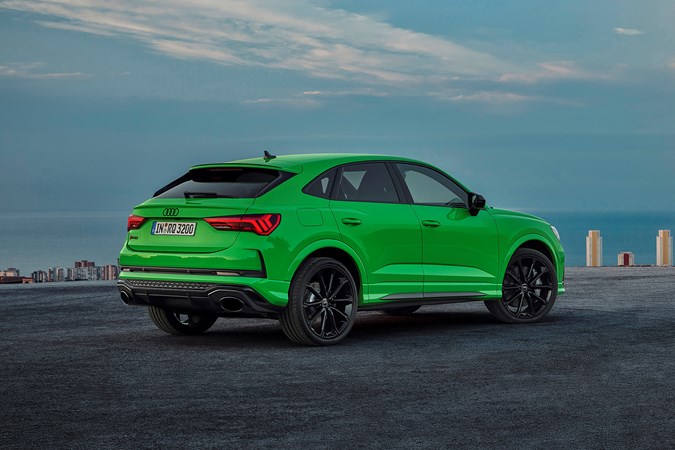
| Long-term test: Audi Q3 |
|
| Mileage | 8,414 |
| Real-world economy | 35.6mpg, 74% of official |
| Official economy / MPP | 47.9mpg / 5.7 - 5.9 |
| Joined Parkers | January 2019 |
By Lawrence Cheung



